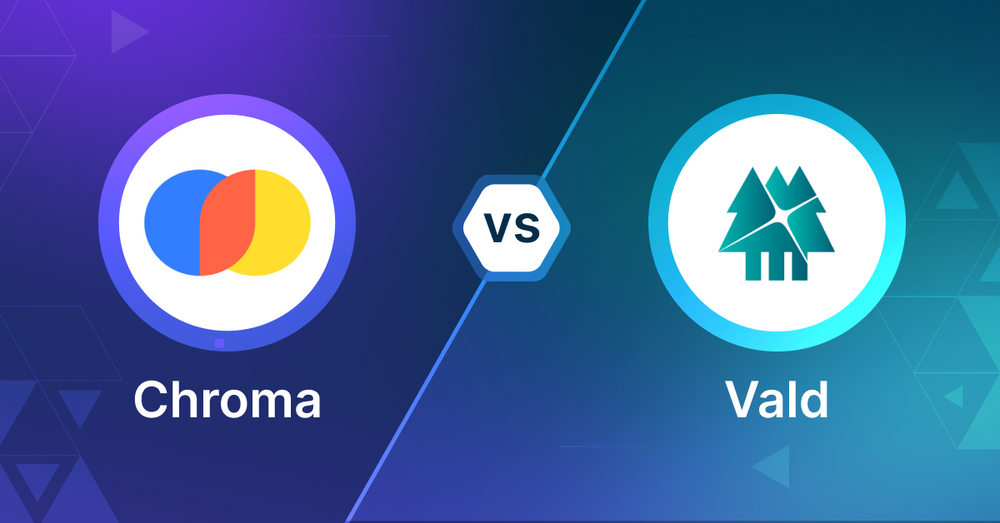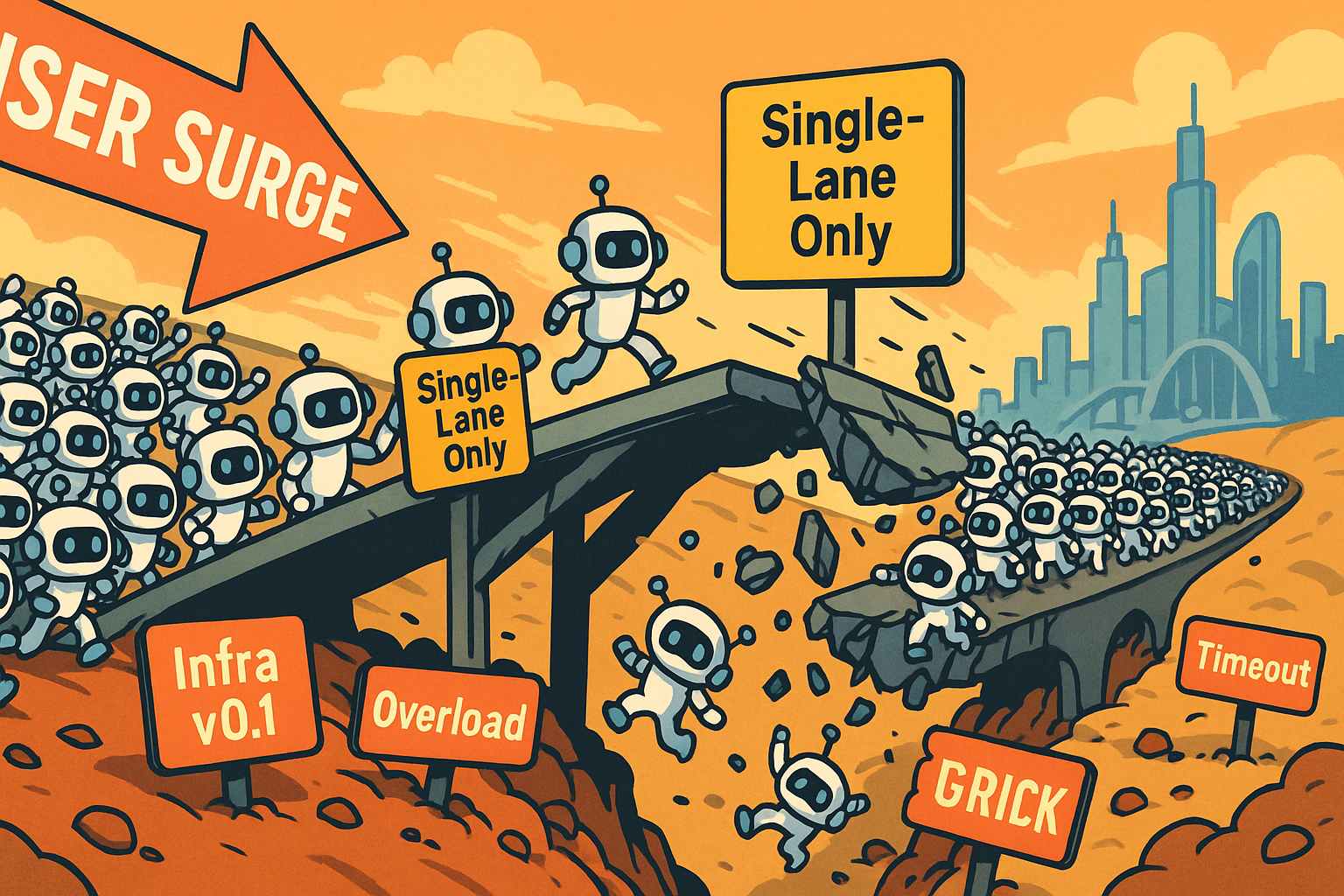Chroma vs Vald: Choosing the Right Vector Database for Your Needs

As AI and data-driven technologies advance, selecting an appropriate vector database for your application is becoming increasingly important. Chroma and Vald are two options in this space. This article compares these technologies to help you make an informed decision for your project.
What is a Vector Database?
Before we compare Chroma and Vald, let's first explore the concept of vector databases.
A vector database is specifically designed to store and query high-dimensional vectors, which are numerical representations of unstructured data. These vectors encode complex information, such as the semantic meaning of text, the visual features of images, or product attributes. By enabling efficient similarity searches, vector databases play a role in AI applications, allowing for more advanced data analysis and retrieval.
Common use cases for vector databases include e-commerce product recommendations, content discovery platforms, anomaly detection in cybersecurity, medical image analysis, and natural language processing (NLP) tasks. They also play a role in Retrieval Augmented Generation (RAG), a technique that enhances the performance of large language models (LLMs) by providing external knowledge to reduce issues like AI hallucinations.
There are many types of vector databases available in the market, including:
- Purpose-built vector databases such as Milvus, Zilliz Cloud (fully managed Milvus)
- Vector search libraries such as Faiss and Annoy.
- Lightweight vector databases such as Chroma and Milvus Lite.
- Traditional databases with vector search add-ons capable of performing small-scale vector searches.
Meta Description: Chroma and Vald are vector databases. This post compares their vector search capabilities.
What is Chroma? An Overview
Chroma is an open-source, AI-native vector database that simplifies the process of building AI applications. It acts as a bridge between large language models (LLMs) and the data they require to function effectively. Chroma's main objective is to make knowledge, facts, and skills easily accessible to LLMs, thereby streamlining the development of AI-powered applications. At its core, Chroma provides tools for managing vector data, allowing developers to store embeddings (vector representations of data) along with their associated metadata. This capability is crucial for many AI applications, as it enables efficient similarity searches and data retrieval based on vector relationships.
One of Chroma's key strengths is its focus on simplicity and developer productivity. The team behind Chroma has prioritized creating an intuitive interface that allows developers to quickly integrate vector search capabilities into their applications. This emphasis on ease of use doesn't come at the cost of performance. Chroma is designed to be fast and efficient, making it suitable for a wide range of applications. It operates as a server and offers first-party client SDKs for both Python and JavaScript/TypeScript, providing flexibility for developers to work in their preferred programming environment.
Chroma's functionality revolves around the concept of collections, which are groups of related embeddings. When adding documents to a Chroma collection, the system can automatically tokenize and embed them using a specified embedding function, or a default one if not provided. This process transforms raw data into vector representations that can be efficiently searched. Along with the embeddings, Chroma allows storage of metadata for each document, which can include additional information useful for filtering or organizing data. Chroma provides flexible querying options, allowing searches for similar documents using either vector embeddings or text queries, returning the closest matches based on vector similarity.
Chroma stands out in several ways. Its API is designed to be intuitive and easy to use, reducing the learning curve for developers new to vector databases. It supports various types of data and can work with different embedding models, allowing users to choose the best approach for their specific use case. Chroma is built to integrate seamlessly with other AI tools and frameworks, making it a good fit for complex AI pipelines. Additionally, Chroma's open-source nature (licensed under Apache 2.0) provides transparency and the potential for community-driven improvements and customizations. The Chroma team is actively working on enhancements, including plans for a managed service (Hosted Chroma) and various tooling improvements, indicating a commitment to ongoing development and support.
What is Vald? An Overview
Vald is a powerful tool for searching through huge amounts of vector data really fast. It's built to handle billions of vectors and can easily grow as your needs get bigger. The cool thing about Vald is that it uses a super quick algorithm called NGT to find similar vectors.
One of Vald's best features is how it handles indexing. Usually, when you're building an index, everything has to stop. But Vald is smart - it spreads the index across different machines, so searches can keep happening even while the index is being updated. Plus, Vald automatically backs up your index data, so you don't have to worry about losing everything if something goes wrong.
Vald is great at fitting into different setups. You can customize how data goes in and out, making it work well with gRPC. It's also built to run smoothly in the cloud, so you can easily add more computing power or memory when you need it. Vald spreads your data across multiple machines, which helps it handle huge amounts of information.
Another neat trick Vald has is index replication. It stores copies of each index on different machines. This means if one machine has a problem, your searches can still work fine. Vald automatically balances these copies, so you don't have to worry about it. All of this makes Vald a solid choice for developers who need to search through tons of vector data quickly and reliably.
Key Differences
When building AI applications that need vector search capabilities, Chroma and Vald offer different solutions to the same problem. Each has its own strengths and quirks that make it better suited for certain use cases. Knowing the differences will help you choose the right tool for your project.
Search Methodology
Chroma takes a user-friendly approach to vector searches, handling most of the complexity for you. You can feed in raw documents and Chroma will convert to vector for you. This abstraction of the technical details is great if you want to build your application rather than manage vector ops. Vald uses the NGT (Neighborhood Graph and Tree) algorithm for similarity searches. This specialized approach is great for massive vector datasets and is a good choice when you have billions of vectors.
Data
How each system handles data reflects their different design. Chroma uses a collection-based approach where related items are grouped together. Each item can store both vector embeddings and additional metadata so you can keep track of what each vector represents and add context to your searches. Vald takes a more focused approach, pure vector ops at scale. It distributes data across multiple machines which is great for large datasets but doesn’t have the same built-in metadata management as Chroma.
Scalability and Performance
When you scale your application the differences become more apparent. Chroma is good for small to medium sized projects, efficient and fast for most use cases. Vald was built for scalability. It can handle billions of vectors, distribute workload across multiple machines and continue to run during index updates. It also manages data backups and load balancing across servers so it’s great for large deployments.
Integration
Integration varies between the two. Chroma has simple integration with Python and JavaScript/TypeScript and support for popular AI frameworks and tools. Great for developers in these environments. Vald has gRPC integration and cloud native architecture with tools for custom data input and output. More flexible for complex distributed systems but requires more technical expertise to implement.
Ease of Use
The ease of use difference is huge. Chroma prioritizes developer experience, you can get started with a few lines of code. The documentation is focused on practical examples and features like auto embedding so you can start working with vectors right away without manual conversion steps. Vald requires more setup and understanding of distributed systems concepts. While it has powerful features you’ll need to understand topics like index replication and distributed computing to use it effectively.
Cost and Resource Requirements
Cost and resource requirements are different between the two. Chroma is free and open-source under the Apache 2.0 license and has plans for a managed service (Hosted Chroma) in development. It requires fewer resources for basic setups, so is more suitable for small projects or teams just starting with vector search. Vald is also open-source but requires more infrastructure planning and more resources due to its distributed nature.
When to Choose Chroma
Choose Chroma for quick setup, good metadata management and Python/JS integration. Perfect for teams building prototypes, medium sized applications or those who want auto document embedding without managing complex infrastructure.
When to Choose Vald
Choose Vald when you have billions of vectors, need built in distributed computing or high availability with fault tolerance. Teams with distributed systems expertise who need continuous indexing without downtime and can manage complex infrastructure.
Conclusion
Chroma is great for ease of use and developer friendliness so perfect for teams that want to get started with vector search quickly. Auto embedding and metadata management makes it great for medium sized applications where simplicity matters more than scale. Vald is great for large scale deployments where performance and distributed computing is important, for teams that have billions of vectors and can manage complex infrastructure. Your choice ultimately depends on your scale requirements, technical expertise and whether you need simple setup or maximum performance. Both are actively maintained open source projects so start with Chroma if you’re new to vector search and look to Vald when you need to scale beyond what Chroma can handle.
While this article provides an overview of Chroma and Vald, it's key to evaluate these databases based on your specific use case. One tool that can assist in this process is VectorDBBench, an open-source benchmarking tool designed for comparing vector database performance. Ultimately, thorough benchmarking with specific datasets and query patterns will be essential in making an informed decision between these two powerful, yet distinct, approaches to vector search in distributed database systems.
Using Open-source VectorDBBench to Evaluate and Compare Vector Databases on Your Own
VectorDBBench is an open-source benchmarking tool designed for users who require high-performance data storage and retrieval systems, particularly vector databases. This tool allows users to test and compare the performance of different vector database systems such as Milvus and Zilliz Cloud (the managed Milvus) using their own datasets and determine the most suitable one for their use cases. Using VectorDBBench, users can make informed decisions based on the actual vector database performance rather than relying on marketing claims or anecdotal evidence.
VectorDBBench is written in Python and licensed under the MIT open-source license, meaning anyone can freely use, modify, and distribute it. The tool is actively maintained by a community of developers committed to improving its features and performance.
Download VectorDBBench from its GitHub repository to reproduce our benchmark results or obtain performance results on your own datasets.
Take a quick look at the performance of mainstream vector databases on the VectorDBBench Leaderboard.
Read the following blogs to learn more about vector database evaluation.
Further Resources about VectorDB, GenAI, and ML
- What is a Vector Database?
- What is Chroma**? An Overview**
- What is Vald**? An Overview**
- Key Differences
- Search Methodology
- Data
- Scalability and Performance
- Integration
- Ease of Use
- Cost and Resource Requirements
- When to Choose Chroma
- When to Choose Vald
- Conclusion
- Using Open-source VectorDBBench to Evaluate and Compare Vector Databases on Your Own
- Further Resources about VectorDB, GenAI, and ML
Content
Start Free, Scale Easily
Try the fully-managed vector database built for your GenAI applications.
Try Zilliz Cloud for FreeKeep Reading

Build for the Boom: Why AI Agent Startups Should Build Scalable Infrastructure Early
Explore strategies for developing AI agents that can handle rapid growth. Don't let inadequate systems undermine your success during critical breakthrough moments.

Introducing DeepSearcher: A Local Open Source Deep Research
In contrast to OpenAI’s Deep Research, this example ran locally, using only open-source models and tools like Milvus and LangChain.

Enhancing AI Reliability Through Fine-Grained Hallucination Detection and Correction with FAVA
In this blog, we will explore the nature of hallucinations, the taxonomy that provides a framework for categorizing them, the FAVABENCH dataset designed for evaluation, and how FAVA detects and corrects errors.
The Definitive Guide to Choosing a Vector Database
Overwhelmed by all the options? Learn key features to look for & how to evaluate with your own data. Choose with confidence.